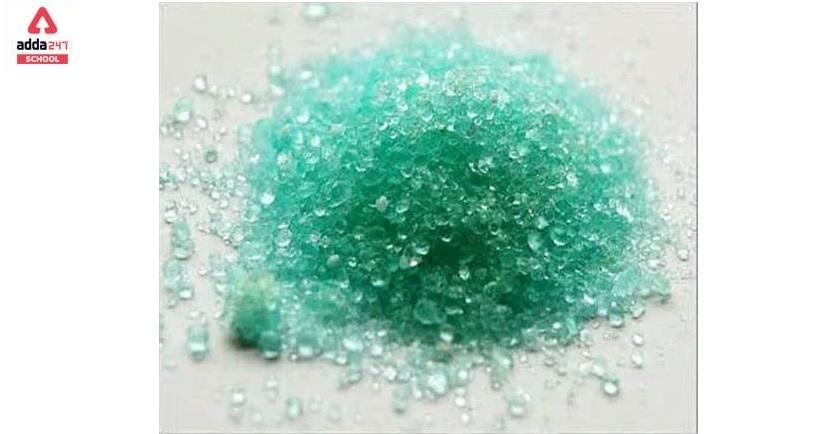Table of Contents
Mohr Salt
Mohr’s salt is an inorganic compound whose chemical formula is represented as Fe (SO4) (NH4)2 (SO4). Mohr’s salt is ammonium iron sulfate. Mohr’s salt contains two primary cations one is an ammonium cation and the other is a ferrous cation. This shows that Mohr’s salt can be categorized as a double salt of ammonium sulfate and ferrous sulfate. Mohr’s salt is easy to keep in laboratories in the form of crystals because it is resistant to oxidation.
What is Mohr’s salt?
Mohr’s salt is prepared by dissolving ammonium sulfate and hydrating ferrous sulfate in water which contains a small amount of sulphuric acid. The solution is then subjected to crystallization to obtain crystals of Mohr’s soul which are light green. The salt undergoes ionization and releases all the cations and anions present in it when it is heated there are some common impurities in Mohr’s salt which include nickel, zinc, lead, magnesium, and manganese. To prevent the hydrolysis of ferrous sulfate, dilute sulphuric acid is added to the solution. To prevent the conversion of fe2+ ions into fe3+ ions the excessive heating of the salt solution is avoided. If the solution turns yellow then the process must be repeated repeat process and attain the light green color of the crystals. If the crystals do not separate after cooling, a few crystals of Mohr’s salt can be added to the concentrated solution to promote the growth of crystals this is generally called ‘seeding’.
Mohr Salt Formula
Mohr’s salt, also known as ammonium ferrous sulfate hexahydrate, has the chemical formula:
(NH4)2Fe(SO4)2·6H2O
This compound is a double salt, meaning it contains two different cations (NH4+ and Fe2+) and two sulfate anions (SO4^2-) in its structure. It also includes six water molecules (hexahydrate) as part of its crystal structure. Mohr’s salt is often used in analytical chemistry as a primary standard for volumetric analysis, particularly in the determination of the concentration of various ions in a solution.
Mohr’s Salt Name
Mohr’s salt is name of ammonium iron sulfate.
Mohr’s Salt Chemical formula
Mohr’s salt, also known as ammonium ferrous sulfate, has the chemical formula (NH4)2Fe(SO4)2·6H2O. It is a double salt, composed of two different cations (ammonium and iron) and two sulfate anions, with six water molecules incorporated into its crystal structure as well. The formula indicates that each formula unit of Mohr’s salt contains two ammonium ions [(NH4)+], one iron(II) ion (Fe2+), two sulfate ions (SO4^2-), and six water molecules (H2O).
Mohr’s Salt Structure
Mohr’s salt is easy to keep in laboratories in the form of crystals because it is resistant to oxidation.
Properties of Mohr’s salt
- The molar mass of Mohr’s salt is 284.05 grams per mole. The hexahydrate of Mohr’s salt has a molar mass of 392.13 grams per mole.
- The density of Mohr’s salt is 1.86 grams per cubic centimeter in standard conditions.
- The physical state of Mohr’s salt is crystalline solids which are bluish-green
- The solubility of Mohr’s salt is 269 grams per liter.
Mohr’s Salt Application
Most salt is the most preferred compound which acts as the source of fe2 ions. Mohr’s salt can be used as solids as the source of the ions. Mohr’s salt is mostly preferred because it has a long shelf life and they’re resistant to oxidation. Oxidation of Mohr’s salt is known to occur quicker when the pH of the environment is high it is important to note that Mohr’s salts are usually acidic which can be explained by the presence of ammonium cations. It can also be noted that sulphuric acid can be added to the solution of Mohr’s salt to prevent the oxidation of ferrous ions to ferric ions. Mohr’s salt is also used in the production of blue iron it is used as a component of iron plating solutions and coloring baths for brass. Mohr’s salt is also used in photography.
Related Post:
- Magnetic Flux- Definition, Density, Formula, SI Unit
- RRB NTPC Full Form In Railways
- Kolbe Electrolysis Reaction- Definition, Mechanism
Molar mass of Mohr salt is
Mohr’s salt, also known as ferrous ammonium sulfate hexahydrate, has the chemical formula Fe(NH4)2(SO4)2·6H2O. To calculate its molar mass, you need to add up the molar masses of all the atoms in the compound, taking into account the number of each type of atom. Here are the molar masses of the individual elements:
- Iron (Fe): 55.85 g/mol
- Nitrogen (N): 14.01 g/mol
- Hydrogen (H): 1.01 g/mol
- Sulfur (S): 32.07 g/mol
- Oxygen (O): 16.00 g/mol
Now, let’s calculate the molar mass of Mohr’s salt:
Molar mass of Fe(NH4)2(SO4)2·6H2O = (1 x 2 x 14.01 g/mol) + (2 x 1 x 1.01 g/mol) + (2 x 32.07 g/mol) + (2 x 4 x 16.00 g/mol) + (6 x 2 x 1.01 g/mol) + (6 x 16.00 g/mol)
= 28.02 g/mol + 2.02 g/mol + 64.14 g/mol + 128.00 g/mol + 12.06 g/mol + 96.00 g/mol
Now, sum up all these values:
Molar mass of Fe(NH4)2(SO4)2·6H2O = 330.24 g/mol
So, the molar mass of Mohr’s salt is approximately 330.24 grams per mole.



 Minimum Marks Required in NEET for MBBS ...
Minimum Marks Required in NEET for MBBS ...
 Navigating the Jump from Class 10 to Cla...
Navigating the Jump from Class 10 to Cla...
 West Bengal HS Result 2025, WBCHSE Class...
West Bengal HS Result 2025, WBCHSE Class...










